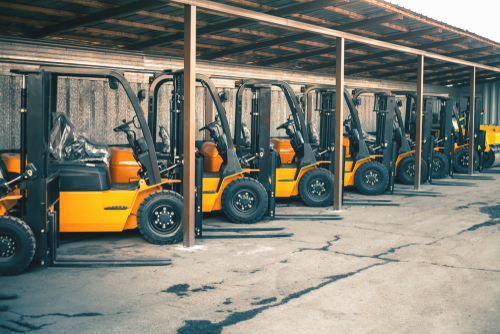Understanding Forklift Weight: Safety, Efficiency, and Compliance
Posted by: admin on March 20, 2025
 Forklifts are essential for warehouses, manufacturing plants, and distribution centers. Knowing how much a forklift weighs is critical for safe operation, proper transport, and OSHA compliance. Operators need extensive knowledge of forklift mechanics, weight distribution, and load limits to reduce accidents. Proper certification through forklifts programs ensures operators understand these concepts and perform their duties safely.
Forklifts are essential for warehouses, manufacturing plants, and distribution centers. Knowing how much a forklift weighs is critical for safe operation, proper transport, and OSHA compliance. Operators need extensive knowledge of forklift mechanics, weight distribution, and load limits to reduce accidents. Proper certification through forklifts programs ensures operators understand these concepts and perform their duties safely.
Why Forklift Weight Matters for Safety and Efficiency
Forklift weight directly affects stability, handling, and workplace safety. Misjudging forklift mass can lead to tip-overs, load shifts, and catastrophic failures. Heavier forklifts require larger clearances and stronger floor support, while lighter models must be operated carefully on uneven surfaces. Factors influencing forklift weight include load capacity, engine type, battery size, and material construction.
How Much Does a Forklift Weigh?
Typical Weight Ranges by Forklift Type
- Light-Duty Forklifts: Typically weigh between 3,000 and 5,000 lbs, ideal for small warehouses and light material handling.
- Medium-Duty Forklifts: Range from 6,000 to 10,000 lbs, suitable for more demanding warehouse operations.
- Heavy-Duty Forklifts: Weigh anywhere from 10,000 to over 50,000 lbs, used for lifting extremely heavy loads in ports, construction sites, and industrial yards.
Light, Medium, and Heavy-Duty Forklifts
Choosing the right forklift weight class ensures stability while preventing equipment strain. Lighter models provide better maneuverability indoors, while heavier models prioritize strength and lifting power.
Understanding Forklift Weight Capacity
How Much Weight a Forklift Can Lift
Forklift weight capacity defines the maximum load a forklift can safely carry. Exceeding this limit compromises stability and operator safety. Common weight capacities include:
- 3,000–5,000 lbs for standard warehouse forklifts
- 10,000–20,000 lbs for industrial forklifts
- 30,000 lbs or more for specialized heavy-duty forklifts
Key Factors That Affect Load Limits
Several factors influence forklift load capacity:
- Fork length and fork condition
- Mast height and angle
- Load size, shape, and weight distribution
- Added attachments like side shifters or clamps
Forklift Load Center & Stability
What Is a Forklift Load Center?
The load center measures the distance from the face of the forks to the load’s center of gravity. Standard forklifts use a 24-inch load center, matching the typical 48-inch pallet dimensions.
How Load Distribution Impacts Stability
Shifting the load’s center of gravity too far forward reduces lifting capacity and increases tipping risk. Maintaining a balanced load center ensures safe forklift operation, especially when stacking heavy materials at height.
How Heavy Is a Standard Forklift?
The average weight of a standard forklift is about 9,000 lbs, roughly three times heavier than a typical passenger car. Forklifts achieve stability using counterweights, usually ranging from 3,000 to 5,000 lbs. These counterweights balance heavy loads carried on the front forks, preventing tip-overs and improving control during operation.
Forklift Weight & Safety Considerations
How Weight Affects Forklift Maneuverability
Heavier forklifts have longer stopping distances and require wider turns. Operators must adjust driving techniques based on forklift weight, paying close attention to surface conditions, slope gradients, and overhead clearances.
Best Practices for Safe Forklift Operation
To maintain safe forklift operation:
- Always check load weights before lifting.
- Conduct pre-operation inspections.
- Operate at safe speeds, especially around corners.
- Use proper braking techniques based on forklift weight.
- Ensure loads are secure, balanced, and within rated capacity.
Choosing the Right Forklift for Your Needs
Selecting a Forklift Based on Weight Capacity
Choosing the correct forklift depends on typical load weights, operating environment, and required lift heights. Underestimating load weights or overextending load centers leads to accidents and equipment failure.
OSHA Guidelines for Proper Forklift Use
OSHA mandates that forklift operators be trained and certified on each type of forklift they use. Understanding forklift load capacities, weight distribution, and load centers forms the foundation of this training.
Enhance Forklift Safety with CertifyMe
Understanding forklift weight, forklift weight capacity, and load center dynamics is essential for every operator. CertifyMe offers industry-leading forklift training that covers all key aspects of forklift operation, safety standards, and OSHA compliance. Build a safer, more efficient workforce with CertifyMe’s convenient certification programs and elevate your material handling operations today.
Welcome to CertifyMe.net
CertifyMe.net has offered online forklift certification since 1999. With Our Convenient online program. your employess can earn their certification in an hour or less.
Browse Online Certifications:
This low-cost program can be compeleted anytime, anywhere!






